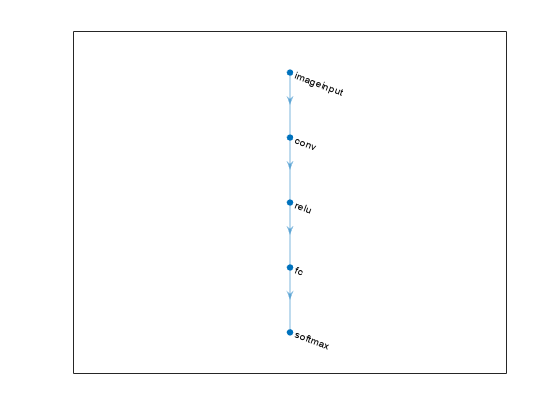getLayer
Description
Examples
Define a simple network architecture and display the network in a plot.
net = dlnetwork;
layers = [
imageInputLayer([28 28])
convolution2dLayer(3,16,Padding="same")
reluLayer
fullyConnectedLayer(10)
softmaxLayer];
net = addLayers(net,layers);
figure
plot(net)
Look up the convolution layer by name. You can then edit the layer and replace it using the getLayer function.
convLayer = getLayer(net,"conv")convLayer =
Convolution2DLayer with properties:
Name: 'conv'
Hyperparameters
FilterSize: [3 3]
NumChannels: 'auto'
NumFilters: 16
Stride: [1 1]
DilationFactor: [1 1]
PaddingMode: 'same'
PaddingSize: []
PaddingValue: 0
Learnable Parameters
Weights: []
Bias: []
Show all properties
If you know the index of the layer, you can alternatively look it up by index.
convLayer = net.Layers(2);
Define a network architecture containing several network layers.
net = dlnetwork;
layers = [lstmLayer(100,OutputMode="sequence")
dropoutLayer(0.2)];
lstmDropoutLayer = networkLayer(layers);
layers = [sequenceInputLayer(3)
lstmDropoutLayer
lstmDropoutLayer
fullyConnectedLayer(10)
softmaxLayer];
net = addLayers(net,layers);Plot the network.
figure plot(net)

Look up the first LSTM layer by specifying the path to the layer. The path includes the name of the network layer ("subnet_1") and the name of the LSTM layer ("lstm"), separated by a forward slash. You can use the path to look up layers nested within a hierarchy of multiple network layers.
tempLSTMLayer = getLayer(net,"subnet_1/lstm");Edit properties of the layer, and replace the original layer with the modified layer.
tempLSTMLayer.InputWeightsInitializer = "zeros"; tempLSTMLayer.RecurrentWeightsInitializer = "zeros"; tempLSTMLayer.BiasInitializer = "ones"; tempLSTMLayer.Name = "modifiedLSTM";
Replace the original layer with the modified layer, specifying the network, the path to the layer to replace, and the modified layer.
net = replaceLayer(net,"subnet_1/lstm",tempLSTMLayer);Input Arguments
Neural network, specified as a dlnetwork object.
Name of layer to look up, specified as a character vector or string scalar.
Example: "conv1"
Data Types: char | string
Path to nested layer, specified as a character vector or string scalar.
For a layer within a networkLayer,
specify layerPath as:
The name of the network layer and the name of the nested layer separated by a forward slash
"/". For example, the path to a layer named"nestedLayerName"in a network layer named"networkLayerName"is"networkLayerName/nestedLayerName". If there are multiple levels of nested layers, then specify the path using the formnetworkLayerName1/.../networkLayerNameN/nestedLayerName.
Custom layers can have a dlnetwork as a learnable or state property. For a
layer of a dlnetwork in the property of a custom layer, specify
layerPath as:
The name of the custom layer, the name of the
dlnetworkproperty, and the name of the nested layer separated by forward slashes"/". For example, the path to a layer named"layerName"inside adlnetworkproperty named"propertyName"of a custom layer named"customLayerName"is"customLayerName/propertyName/layerName". If there are multiple levels of nested layers, then specify the path using the form"customLayerName1/propertyName1/.../customLayerNameN/propertyNameN/layerName".
Data Types: char | string
Version History
Introduced in R2024a
MATLAB Command
You clicked a link that corresponds to this MATLAB command:
Run the command by entering it in the MATLAB Command Window. Web browsers do not support MATLAB commands.
Select a Web Site
Choose a web site to get translated content where available and see local events and offers. Based on your location, we recommend that you select: .
You can also select a web site from the following list
How to Get Best Site Performance
Select the China site (in Chinese or English) for best site performance. Other MathWorks country sites are not optimized for visits from your location.
Americas
- América Latina (Español)
- Canada (English)
- United States (English)
Europe
- Belgium (English)
- Denmark (English)
- Deutschland (Deutsch)
- España (Español)
- Finland (English)
- France (Français)
- Ireland (English)
- Italia (Italiano)
- Luxembourg (English)
- Netherlands (English)
- Norway (English)
- Österreich (Deutsch)
- Portugal (English)
- Sweden (English)
- Switzerland
- United Kingdom (English)